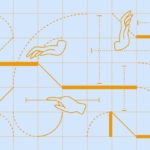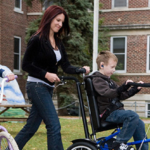Surf therapy improves physical fitness of children with CP
Surf therapy is a viable therapeutic option to improve physical fitness among children living with physical disabilities due to cerebral palsy, a study says.

Surf’s up, mate. These days, graduate student Kelli Hingerton is on the western coast of Australia—launching a surf therapy program for children with disabilities. “This is my dream,’’ says Hingerton. “Surfing has always been a part of my life. To be able to share that passion with children across the world is exciting.’’ Emily Clapham, an associate professor of kinesiology in the College of Health Sciences, created the surf therapy program in 2010 at Narragansett Town Beach, but this is the first effort to bring it to an international group. Photo by Corey Favino, a photography student at University of Rhode Island.
By Joana Carvalho MSc, Cerebral Palsy News Today August 26, 2019
The findings of the study were published in Disability and Health Journal. Previous studies have shown that surfing can have several health benefits, ranging from improvements in heart and lung function to increased strength and physical fitness.
However, few studies have investigated the potential benefits of surfing for children with physical disabilities associated with certain neuro-developmental disorders, including cerebral palsy (CP) and autism-spectrum disorders (ASDs).
Researchers from the University of Rhode Island set out to evaluate the effects of an eight-week surf therapy program on several parameters of physical fitness. The program was targeted to children with physical disabilities associated with ASDs, CP, Down syndrome, Dandy-Walker syndrome, and other neuro-developmental disorders.

Surf Emporium Muizenberg, Cape Town, South Africa
A group of children participating in an eight-week unstructured pool playgroup served as a reference for comparison with children participating in the surf therapy program. Statistical analyses were used to compare overall physical fitness between the two groups of children.
All physical fitness parameters that were analyzed before and after both interventions were selected from the Brockport Physical Fitness Test (BPFT).
A total of 71 children — 18 girls and 53 boys with a mean age of 12.6 years — participated in the eight-week surf therapy program. Meanwhile, 20 children — eight girls and 12 boys with a mean age of 11.1 years — participated in an unstructured aquatic playgroup program.
Results showed that children who completed the eight-week surf therapy program had significant improvements in core strength — including abdominal, back, and pelvic muscle strength — upper body strength, flexibility, and cardiorespiratory endurance.
After the program, these children also had a significant reduction in the total amount of body fat and fat free mass, together with a significant increase in bone mineral density. Bone mineral density is a measure of bone density. Lower bone mineral density is associated with higher bone fragility and greater propensity to fractures.
Children who completed the eight-week unstructured aquatic playgroup program also had significant improvements in all parameters analyzed. Statistical analyses found no significant differences in overall physical fitness nor in any of the individual fitness parameters analyzed between the two groups of children.
“Our analyses indicate that both the surfing group and the unstructured pool-play group made significant improvements in physical fitness after an eight-week program,” the researchers said.
Nevertheless, according to the investigators, this study demonstrated “that a surfing intervention is feasible, as well as beneficial to the physical fitness of children with disabilities.”
“Based on the fitness testing and feedback from participants and parents, it appears that a surfing intervention can be effective in improving the lives of children with disabilities. We had no untoward events occur and therefore health and physical education departments might consider incorporating surfing into their curriculum as a way to provide variety,” they concluded.
| Joana Carvalho MSc |
| Joana is currently completing her PhD in Biomedicine and Clinical Research at Universidade de Lisboa. She also holds a BSc in Biology and an MSc in Evolutionary and Developmental Biology from Universidade de Lisboa. Her work has been focused on the impact of non-canonical Wnt signaling in the collective behavior of endothelial cells — cells that make up the lining of blood vessels — found in the umbilical cord of newborns. |
Source Cerebral Palsy News Today
| References |
Effectiveness of surf therapy for children with disabilities, Clapham ED, Lamont LS, Shim M, Lateef S, Armitano CN. Disabil Health J. 2019 Aug 2:100828. doi: 10.1016/j.dhjo.2019.100828. [Epub ahead of print] PDF
| 2017 STANCE ISA World Adaptive Surfing Championship – Meet Alana Nichols. ISAsurfing. Youtube Dec 1, 2017 |
| Further reading |
Effects of aquatic exercise on health-related physical fitness, blood fat, and immune functions of children with disabilities. Kim KH, Lee BA, Oh DJ. J Exerc Rehabil. 2018 Apr 26;14(2):289-293. doi: 10.12965/jer.1836068.034. eCollection 2018 Apr. Full text
A Case Report Illustrating the Implementation of a Therapeutic Surfing Intervention for an Adolescent with Autism, Emily D. Clapham, Linda S. Lamont, Minsuk Shim, Cortney Armitano. Palaestra. 2018, Vol. 32 Issue 2, p49-53. 5p.
“When I Go There, I Feel Like I Can Be Myself.” Exploring Programme Theory within the Wave Project Surf Therapy Intervention, Marshall J, Kelly P, Niven A. Int J Environ Res Public Health. 2019 Jun 18;16(12). pii: E2159. doi: 10.3390/ijerph16122159 Full text
Parents’ Perspectives on Surf Therapy for Children with Disabilities, Adam M. Moore, Emily D. Clapham & Theresa A. Deeney. International Journal of Disability, Development and Education, 2018 65:3, 304-317, DOI: 10.1080/1034912X.2017.1400660
Benefits of Surfing for Children with Disabilities: A Pilot Study, Armitano CN, Clapham ED, Lamont LS, & Audette JG. (2015) Palaestra. 29(3), 31-34. doi: 10.18666/PALAESTRA-2015-V29-I3-6912 PDF
Development of a Wet Suit for Children With Down’s Syndrome, Lamont, Linda Suzan; Panagiotis, Peter; Armitano, Cortney; and Clapham, Emily. (2014) International Journal of Aquatic Research and Education: Vol. 8 : No. 1 , Article 9. DOI: 10.25035/ijare.08.01.09 PDF
The Ocean as a Unique Therapeutic Environment: Developing a Surfing Program, Emily D. Clapham, Cortney N. Armitano, Linda S. Lamont & Jennifer G. Audette. Journal of Physical Education, Recreation & Dance, 2014. 85:4, 8-14, DOI: 10.1080/07303084.2014.884424 PDF
| How do you water ski when you can’t use your legs? BBC security correspondent Frank Gardner has used a wheelchair since being shot on assignment in Saudi Arabia in 2004. A competent water skier before his injury, he had heard of “adaptive water skiing” but says it had been that “one challenge too far” – until now. Greg Brosnan, BBC Video journalist 09 Sep 2019 |
Also see
‘Hawaii, Bristol, it’s just as fun’: world’s top adaptive surfers take to The Wave The Guardian
2020 English Adaptive Surfing Open at The Wave is ON Surfing England
Surfing With a Disability The New York Times
Surf’s Up University of Rhode Island
Surf’s up for URI graduate student bringing surf therapy program to Australia University of Rhode Island
Adaptive Athletes surf through Boulder Reservoir 9NEWS KUSA-TV Denver CO
Adaptive Surfing / Surfing With A Disability Surf Emporium Surf School, Cape Town, South Africa
2018 World Adaptive Surfing Championship Surf Canada
ISA Adaptive Surfing in The International Surfing Association (ISA)
‘A way to find the peace I lost’: This Maryland nonprofit is teaching people with disabilities how to sail boats The Washington Post






